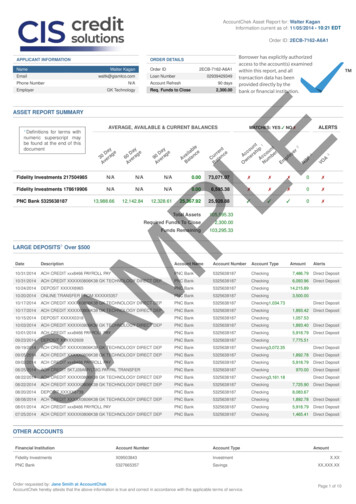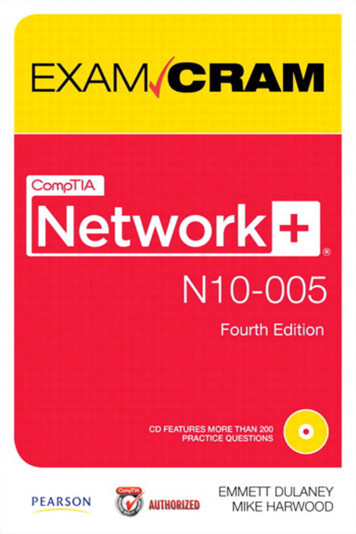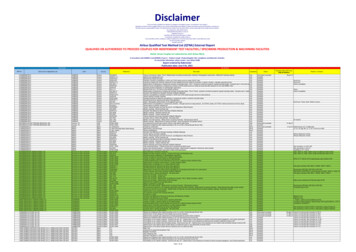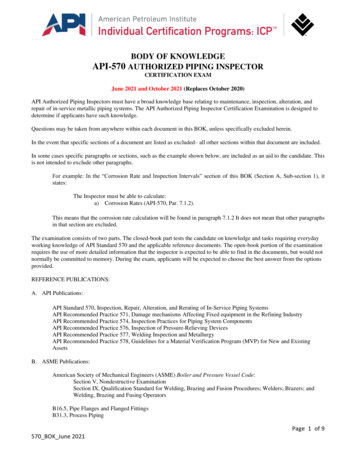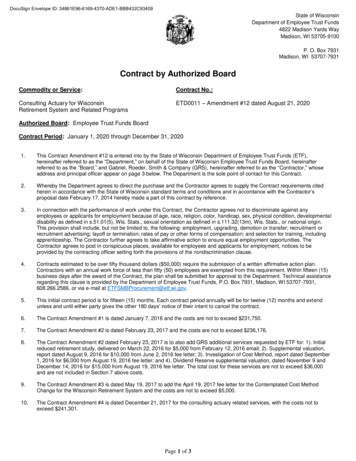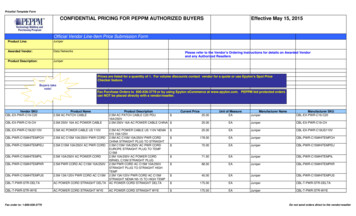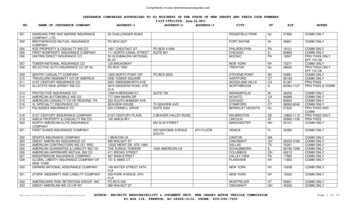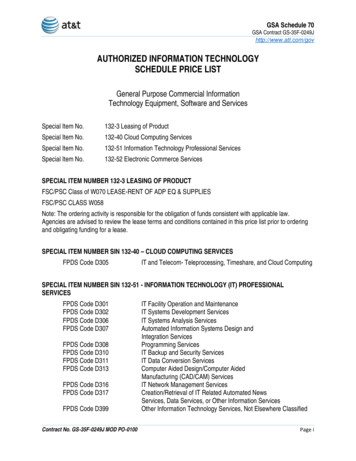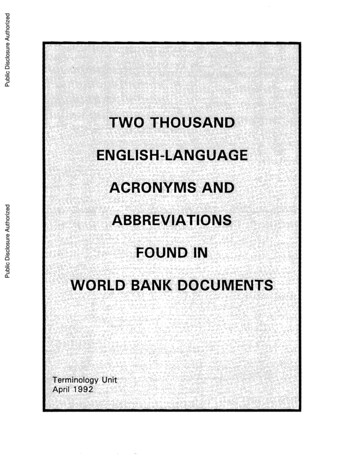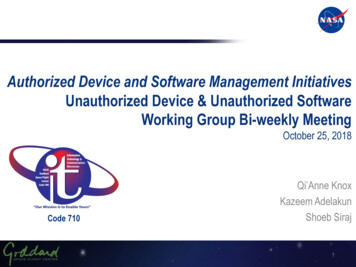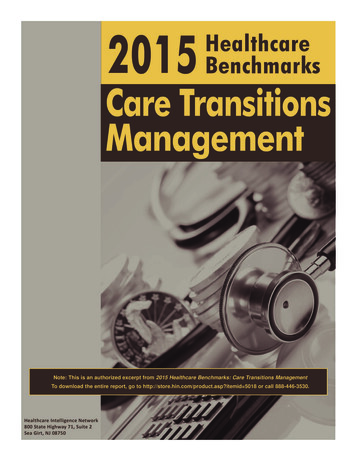
Transcription
Note: This is an authorized excerpt from 2015 Healthcare Benchmarks: Care Transitions ManagementTo download the entire report, go to http://store.hin.com/product.asp?itemid 5018 or call 888-446-3530.
2015 Healthcare Benchmarks:Care Transitions Management116 healthcare organizations describe how they are working to manage caretransitions and patient handoffs, including risk stratification methods fortransition management, favored care transition models, effective tools andpartnerships, most successful strategies for coordination of care transitions,and more.Most successful strategy: “Utilization of a triage RN who screens, discharges andassigns patients to case management team members. Case managers contactthe patients within 72 hours of discharge and patients are scheduled to be seenby their PCPs within 7-10 days.” Health plan“Patients who have no primary care provider have problems post-dischargegetting home health authorized and seem to fall through cracks.” Hospital/health systemMost successful strategy: “Connecting with the patient/family after patient isback home to review the discharge plan and asking for teach-back.” ConsultantSuccessful partnership: “Community partnerships with area hospitals, skillednursing facilities, nursing homes, and home health agencies, as well as AreaAgencies on Aging (AAA).” Hospital/health system 2015, Healthcare Intelligence Network — http://www.hin.com2
2015 Healthcare Benchmarks:Care Transitions ManagementThis special report is based on results from the Healthcare Intelligence Network’sfourth annual survey on Care Transitions Management conducted in February 2015.Executive EditorMelanie MatthewsHIN executive vice president and chief operating officerProject EditorsPatricia DonovanCheryl MillerDocument DesignJane Salmon 2015, Healthcare Intelligence Network — http://www.hin.com3
Table of ContentsAbout the Healthcare Intelligence Network. 6Executive Summary. 6Survey Highlights. 7Key Findings. 7Program Components. 7Results and ROI. 7Methodology. 8Respondent Demographics. 8Using This Report. 9Responses by Sector.10The Hospital/Health System Perspective. 13The Consultant Perspective. 14The Home Health Perspective.15Year-Over-Year Survey Data. 16Respondents in Their Own Words. 19Partnerships to Improve Transitions of Care . 19Most Effective Strategy, Tool, Protocol or Work Flow.20Plans for Future Programs. 22Additional Comments. 23Conclusion. 24Streamlining Cross-Continuum Care Transitions.25Responses to Questions.25Figure 1: All - Have Program to Manage Care Transitions.26Figure 2: All - Planning Future Program. 26Figure 3: All - Most Critical Care Transition. 27Figure 4: All - Targeted Conditions. 27Figure 5: All - Risk Factors for Care Transition Management.28Figure 6: All - Program Models. 28Figure 7: All - Transition Management Tools.29Figure 8: All - Options for Transitioning Patients.29Figure 9: All - Transmitting Patient Information.30Figure 10: All - Discharge Summary Data.30Figure 11: All - Responsible for Managing Care Transitions. 31Figure 12: All - Challenges of Care Transition Management. 31Figure 13: All - Program Impacts. 32Figure 14: All - Key Success Measures. 32Figure 15: All - Program ROI. 33Figure 16: All - Organization Type. 33Figure 17: Hospital - Have Program to Manage Care Transitions.34Figure 18: Hospital - Planning Future Program.34Figure 19: Hospital - Most Critical Care Transition. 35Figure 20: Hospital - Targeted Conditions. 35Figure 21: Hospital - Risk Factors for Care Transition Management.36 2015, Healthcare Intelligence Network — http://www.hin.com4
Figure 22: Hospital - Program Models.36Figure 23: Hospital - Transition Management Tools. 37Figure 24: Hospital - Options for Transitioning Patients. 37Figure 25: Hospital - Transmitting Patient Information.38Figure 26: Hospital - Discharge Summary Data.38Figure 27: Hospital - Responsible for Managing Care Transitions.39Figure 28: Hospital - Challenges of Care Transition Management.39Figure 29: Hospital - Program Impacts. 40Figure 30: Hospital - Key Success Measures. 40Figure 31: Hospital - Program ROI. 41Figure 32: Consultant - Have Program to Manage Care Transitions. 41Figure 33: Consultant - Planning Future Program.42Figure 34: Consultant - Most Critical Care Transition.42Figure 35: Consultant - Targeted Conditions.43Figure 36: Consultant - Risk Factors for Care Transition Management.43Figure 37: Consultant - Program Models.44Figure 38: Consultant - Transition Management Tools.44Figure 39: Consultant - Options for Transitioning Patients.45Figure 40: Consultant - Transmitting Patient Information.45Figure 41: Consultant - Discharge Summary Data.46Figure 42: Consultant - Responsible for Managing Care Transitions.46Figure 43: Consultant - Challenges of Care Transition Management. 47Figure 44: Consultant - Program Impacts. 47Figure 45: Consultant - Key Success Measures.48Figure 46: Consultant - Program ROI.48Appendix A: 2015 Care Transitions Management Survey Tool. 49 2015, Healthcare Intelligence Network — http://www.hin.com5
About the Healthcare Intelligence NetworkThe Healthcare Intelligence Network (HIN) is an electronic publishing companyproviding high-quality information on the business of healthcare. In one place,healthcare executives can receive exclusive, customized up-to-the-minuteinformation in five key areas: the healthcare and managed care industry,hospital and health system management, health law and regulation, behavioralhealthcare and long-term care.67% ofrespondentshaveprograms tomanage caretransitions.Executive SummaryCall it Care Transitions Management 2.0—enterprising approaches rangingfrom recording patient discharge instructions to enlisting fire departments andpharmacists to conduct home visits and reconcile medications. To improve30-day readmissions and avoid costly Medicare penalties, more than one-thirdof respondents to the 2015 Care Transitions Management survey—34 percent—have designed programs in this area, drawing inspiration from the Coleman CareTransitions Program , Project BOOST , Project RED, Guided Care and othermodels.Whether self-styled or off the shelf, the approaches enhance both quality of careand utilization metrics, according to this fourth annual Care Transitions snapshotby the Healthcare Intelligence Network. Seventy-four percent of respondentsreported a drop in readmissions; 44 percent saw decreases in lengths of stay; 38percent saw readmissions penalties drop; and 65 percent said patient complianceimproved.The survey also pinpointed more than a dozen ideas for care transitioncollaborations between providers and communities, including a post-acute carecoalition and a community health coach program.With communication between care sites a top barrier to efficient transitionsfor one quarter of respondents, this year’s survey identified information toolsemployed during patient discharge and handoff. Technology offers a leg upby way of telehealth and remote monitoring, and 75 percent of respondentstransmit patient discharge or transition information via electronic medicalrecords (EMR). 2015, Healthcare Intelligence Network — http://www.hin.comCTM Partnership:“Communitypartnerships witharea hospitals,SNFs, nursinghomes, and homehealth agencies,as well as AreaAgencies on Aging(AAA).”6
Using This ReportThis benchmarking report is intended as a resource for healthcare organizationssearching for comparable data and means to measure implementation and progress.It is also a helpful planning tool for organizations readying initiatives in this area.The initial charts and graphs presented represent results from all respondents;images in subsequent sections depict data from high-responding sectors. (Figure titlesbegin with the segment they represent; for example, All, Health Plans, Hospitals, etc.)Often, one of the largest responding sectors is composed of respondents identifyingtheir organization type as “Other.” In general, we do not depict results fromthis segment because it represents a wide range of organization types, includingconsultants and product vendors. However, you will always find a graph indicatingthe demographics of respondents.Recenthospitalizationsis the top riskfactor for caretransitionmanagement,say 83% ofrespondents.Here are some additional tips for using this report:99 See how you measure up: Scan this report for your sector, and see how yourprogram compares to others. Note where you are leading and where you arebehind.99 Evaluate your efforts: Think about where you have been focusing your efforts inthis area. Look for trends in the data in this report. Look for benchmarks set byyour sector and others.99 Set new goals:Use the data in this report to set new goals for your organization,or to raise the bar on existing efforts.99 Use it as a reference book: Keep this report accessible so you can refer to it inyour work. Use these data to support your efforts in this area.If you have questions about the data in this report, or have feedback for our team,don’t hesitate to contact us at info@hin.com or 732-449-4468. 2015, Healthcare Intelligence Network — http://www.hin.com“Patients whohave no primarycare providerhave problemspost-dischargegetting homehealth authorizedand seem to fallthrough cracks.”9
Figure 21: Hospital - Risk Factors for Care Transition ManagementWhich risk factors qualify individuals for your quent ER use68.2%Frail/elderly31.8%Other27.3%Cognitive impaired22.7%Poor self-health22.7%Homelessness18.2%13.6%SA/mental IN Care Transitions Management in 2015 SurveyFebruary, 2015 2015Figure 22: Hospital - Program ModelsOn which model is your care transitions program based?0.0%13.6%9.1%4.5%0.0%Coleman CTIGuided Care (0%)Transitional Care ModelAD-LIFE (0%)18.2%Project BOOST9.1%Project REDCMS pedOther 2015 2015, Healthcare Intelligence Network — http://www.hin.comHIN Care Transitions Management in 2015 SurveyFebruary, 201536
Healthcare Intelligence Network BenchmarkMembers Received This Report for FREE!Sign up today for 695 for a year of Healthcare Benchmark DataFax Form to: 732-449-4463The Healthcare Intelligence Network’s HealthcareBenchmarking Series provides continuous qualitativedata on industry trends to empower healthcare companies toassess strengths, weaknesses and opportunities to improve bycomparing organizational performance to reported metrics.As a HIN Benchmarks Member you will have access to ALL ofour benchmark reports published during your membership year.Sign up today for just 695 per year, a savings of over 500.You’ll get: Feedback from 1,000 respondents annually; Thousands of sector-specific data points, sortedby hospital, health plan and provider; Year-over-year data analysis; 8 to 10 trending topics annually;Upcoming topics include: Care Transitions Telehealth Other key topics of interest to healthcare executives.As a subscriber, you will also have direct access to: Auto-delivery of new benchmarks to your emailbox; Preview copy of the latest executive summaries - even beforerespondents; eNewsletters of your choice; Healthcare Infographics; White Papers and Case Studies; Educational Videos; eBooks; and Healthcare Podcasts.Learn more about why you shouldbecome a HIN Benchmark SeriesMember, scan with your smart phoneQR reader to view HIN’s BenchmarkSeries Membership Infographic.Thank You For Your Order!Five easy ways to order:TT Yes, I need actionable healthcare metrics on the industry’stop trends. Please sign me up for HIN’s Benchmark SeriesMembership, today for 695.1. Online:http://store.hin.com/product.asp?itemid 46642. Phone: 888-446-35303. Fax: 732-449-44634. Email: info@hin.comTax ID No.06-15155905. Mail to:Healthcare Intelligence NetworkPO Box 1442, Wall, NJ 07719-1442TT Check Enclosed - payable toHealthcare Intelligence Network in U.S.dollars - NJ residents, pleaseadd 7% sales taxCharge myVisaMCAMXName & t No.Exp. DateSignatureSecurity CodeIPF
Care Transitions Management 116 healthcare organizations describe how they are working to manage care transitions and patient handoffs, including risk stratification methods for transition management, favored care transition models, effective tools and partnerships, most successful strategies for coo


